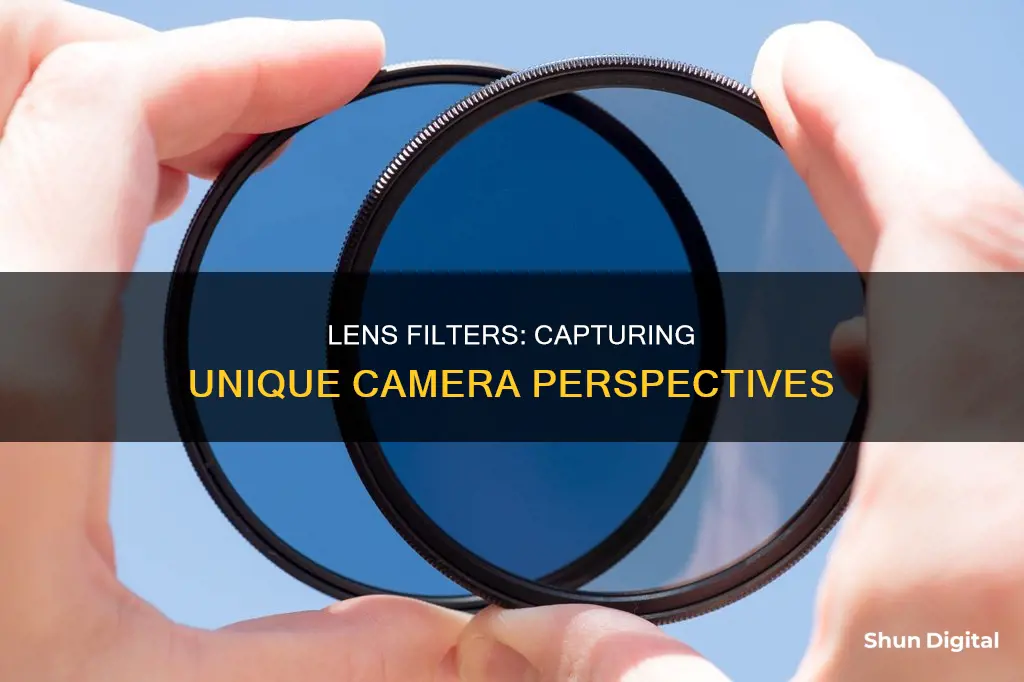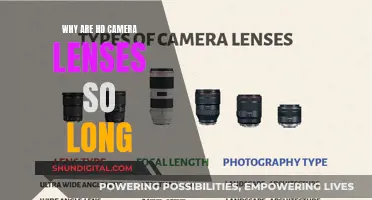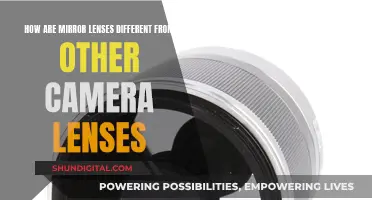
Camera lens filters are accessories that can be placed on a camera lens to protect it, manage lighting, or produce specific effects such as changing colours. They are mostly made of high-quality glass, plastic, or resin and are used to block certain colours or types of light coming into the camera.
Filters can be used to remove reflections, enhance particular colours in an image, or limit the amount of light that passes through the lens. They are available in different shapes, sizes, and materials and attach to the camera lens in different ways.
The most common and popular form is the circular screw-on filter, which simply screws onto the filter threads found on the front of a camera lens. The second most common form is the square filter, which requires a holder to be used on a lens. Rectangular filters are also popular, especially with landscape photographers, as they are most commonly available in this form.
| Characteristics | Values |
|---|---|
| Purpose | Protection, light manipulation, colour correction, adding in-camera effects, removing unwanted reflections |
| Forms | Circular screw-on, square, rectangular, drop-in, sensor clip-in |
| Types | Protection, UV, IR, ND, GND, CPL, light pollution, coloured/cooling/warming, diffusion, close-up, star |
What You'll Learn

Protect the lens from scratches, dust, and water
Protecting Your Camera Lens from Scratches, Dust, and Water
Camera lenses are expensive, and their glass elements are delicate. It is important to protect them from scratches, dust, and water damage. Here are some ways to do that:
- Use a UV filter: A UV filter is a clear glass filter that you can mount onto the front element of your lens. While it does not have any creative effect on your photography, it acts as an additional layer of protection. If you accidentally scratch or bump your lens, the UV filter will take the hit instead of the lens. UV filters are cheap and easy to replace, so it is a good idea to get one for all your most-used lenses.
- Use a lens hood: Lens hoods are designed to cut glare and protect your lens from the elements. They also provide some protection from scratches since they extend a few inches past the front element of the lens, making it less likely that something will strike the glass directly.
- Use a camera bag: A dedicated camera bag has padded compartments to fit different lenses and cameras, limiting movement and keeping gear padded from bumps and knocks.
- Keep your gear dry: If you've been shooting in the rain, be sure to wipe off any visible water from your camera and lenses with a towel, and then let them air-dry before putting them back into your bag. You can also keep silica gel packs in your camera bag to absorb any surrounding moisture or condensation.
- Use lens caps: Both front and back lens caps are important for protecting your lenses, even when they are stored in your camera bag.
- Clean your gear regularly: Use microfiber lens cloths, puffers, and a cleaning solution to keep dust and dirt from building up on your camera and lenses.
- Be careful when changing lenses: Minimize the time your lens port is open to reduce the risk of dust or water getting inside your camera body.
Camera Lenses: Tax Benefits and What Qualifies as 'Listed Property
You may want to see also

Enhance colours and reduce reflections
Lens filters can enhance colours and reduce reflections in several ways.
Polarizing filters, for example, are a popular choice for photographers looking to reduce reflections and glare from surfaces. They can also enhance colours, deepen blue skies, and increase overall contrast. These filters are ideal for landscape photography, especially when shooting near water or glass surfaces.
UV filters, which are designed to block UV light, can also enhance colours and reduce reflections. They are clear to the naked eye but have a thin coating that blocks UV light, which can cause haze and fogginess in images.
Another option is to use a coloured filter, such as a warming or cooling filter, to enhance certain colours in an image. These filters can add mood to a photo by altering the colour balance of a scene.
Additionally, neutral density (ND) filters can be used to reduce the amount of light entering the lens, allowing for slower shutter speeds and wider apertures. This can be useful for creating motion blur and enhancing colours, especially when shooting in bright environments.
Finally, lens filters can also help to protect lenses from scratches, cracks, and dust, ensuring that your images remain clear and sharp.
The High Cost of Camera Lenses: Why So Expensive?
You may want to see also

Reduce light coming into the lens
Filters can be used to reduce the amount of light entering the lens in photography. This is particularly useful when working with particularly challenging lighting conditions, as they can help you achieve even and accurate exposure across your entire image.
Neutral-density (ND) filters are sheets of dark-coloured glass that reduce the amount of light that enters your lens and hits the sensor. They do this without affecting the colour of the resulting image. ND filters are available in varying strengths, from 2-stop filters to 10-stop filters, which block a smaller or larger amount of light, respectively. Some ND filters are also variable, allowing you to rotate them to block more or less light as needed.
Graduated neutral-density (GND) filters are another type of filter that can be used to reduce light entering the lens. They are typically rectangular and are used to balance the luminosity of a scene, such as a bright sky and a darker ground. GND filters have a vertical transition between dark and clear, with the upper side being darker and acting like a regular ND filter, while the bottom part is clear glass.
In addition to ND and GND filters, circular polarising filters (CPL) can also help reduce light entering the lens by reducing glare and enhancing contrast.
The Magic of Camera Lenses: How They Attach
You may want to see also

Create specific effects, such as multi-point stars on light sources
Camera lens filters are tools that aid photographers in controlling and manipulating light, changing and correcting colours, adding in-camera effects, and removing unwanted reflections. One of the effects that can be created using lens filters is adding multi-point stars on light sources. This is achieved using a star filter, which is a type of special effects filter.
A star filter produces stars around point light sources, and they usually come in two forms: one that produces a 4-peak star, and one that produces a 6-peak star. However, the number of points in the star can be customised to the photographer's liking. The star effect can also be achieved with almost any lens by using a very small aperture, such as f/16 or f/22.
Special effects filters can be used to produce some cool effects, but since most of these effects can now be easily replicated in photo editing software, these filters have lost some of their popularity. However, the unique effects of bokeh filters on out-of-focus blur cannot be easily replicated.
In addition to star filters, other types of special effects filters include infrared filters, multivision filters, centre spot or diffusion filters, and day-for-night filters.
Cleaning Camera Contacts: A Step-by-Step Guide
You may want to see also

Correct colour temperature
Colour temperature is a measure of the warmth or coolness of light, which is expressed in Kelvin (K). The higher the number, the colder or whiter the light. For example, a candle emits a reddish light at 1850 K, while the midday sun's rays are bluer at 5500 K.
Cameras cannot automatically adjust to different colour temperatures like the human eye, so photographers need to correct for any colour casts by adjusting the white balance. This can be done by telling the camera the type of lighting (e.g. daylight, shade, tungsten) or by setting an exact colour temperature in Kelvin.
Lens filters can be used to correct colour temperature. A UV filter, for example, blocks UV light, which cannot be seen by the human eye but can affect the colour temperature of a photo. A UV and IR cut filter can be used to restore a camera to its factory state after the internal UV and IR filters have been removed, which is often done by photographers working in astrophotography or fine art black and white photography.
Camera Lenses: Waterproof or Not?
You may want to see also
Frequently asked questions
Camera lens filters are accessories that can be placed on the lens to protect it, manage lighting, or produce specific effects such as changing colours. They are mostly made of high-quality glass, plastic or resin and are available in different shapes, sizes and materials.
There are many different types of lens filters available, including:
- Polarising filters
- Neutral density filters
- Graduated neutral density filters
- UV filters
- Colour filters
- Night filters
- Macro filters
- Infrared filters
- Special effects filters
The benefits of using lens filters include:
- Protecting the lens from falls, scratches, dust and water
- Reducing reflections
- Enhancing colours and contrast
- Controlling lighting
- Creating specific effects, such as changing colours or eliminating reflections







